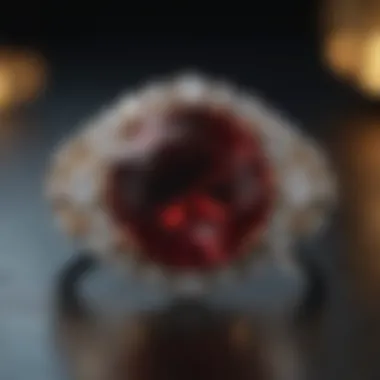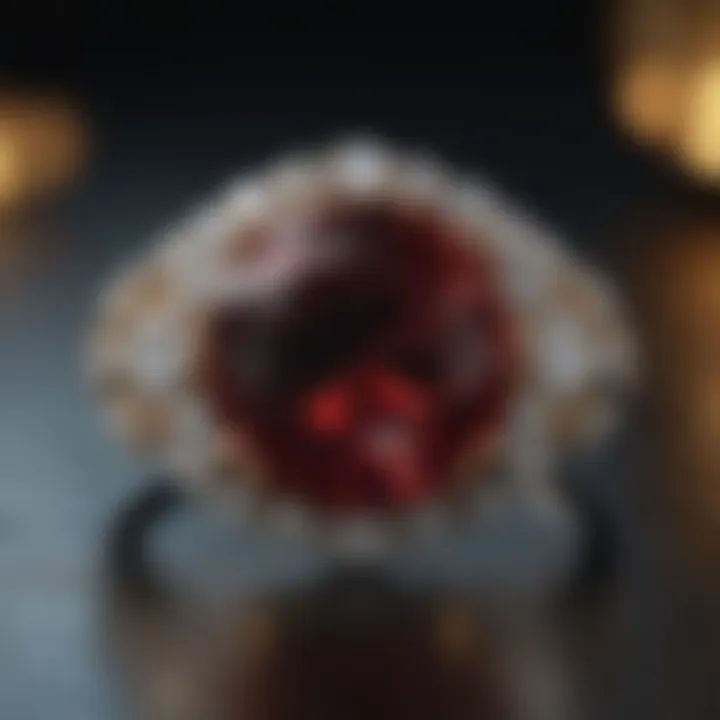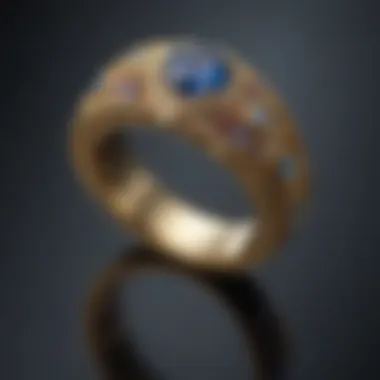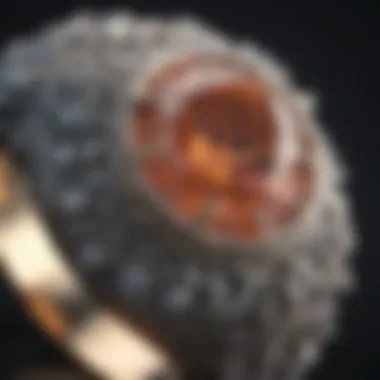Choosing the Ideal Investment for a Ring


Intro
Choosing the right investment for a ring can be an overwhelming task. It encompasses not just the financial aspect, but also emotional, cultural, and personal considerations. Understanding these variables is crucial for making a well-informed choice. The aim of this article is to guide you through the process, ensuring that your investment aligns with your values, societal expectations, and current market trends.
The significance of rings, especially in engagements and important life events, is profound. They symbolise commitment, love, and personal milestones. This article addresses the key aspects involved in determining how much to spend on a ring, while also shedding light on gemstones and their intrinsic properties. Ultimately, the goal is to empower you to make a meaningful and resourceful investment in a piece that holds lasting value.
Gemstone Overview
Definition and Characteristics
Gemstones are naturally occurring minerals, rocks, or organic materials that are cut and polished to create jewelry. These materials often exhibit aesthetic appeal due to their color, clarity, and rarity. Key attributes such as hardness and brilliance additionally enhance their desirability. Specifically, stones like diamonds, sapphires, and rubies have captivating qualities that contribute to their use in high-end jewelry. Value is often determined based on the stone’s origin, beauty, and market demand.
Classification of Gemstones
Gemstones can be categorized in various ways:
- Precious Gemstones: These include diamonds, sapphires, rubies, and emeralds, appreciated for their rarity and exceptional quality.
- Semi-Precious Gemstones: This category encompasses a broader range, including amethyst, topaz, and garnet. While not as rare, they still offer beauty and unique characteristics.
- Organic Gemstones: These include pearls and amber, formed through biological processes.
Understanding the classification helps in making informed decisions about what type of gemstone aligns with your personal values and investment goals.
Properties of Gemstones
Physical Properties
Physical properties play a critical role in assessing the value and durability of gemstones. Some of these include:
- Hardness: Measured on the Mohs scale, this indicates a stone's resistance to scratching. For example, diamonds rank highest at 10.
- Clarity: This refers to the presence of internal or external flaws. Higher clarity usually means greater value.
- Color: Gemstones come in various colors; some colors are more desirable than others, impacting their market price.
- Cut: The way a gemstone is fashioned affects its brilliance and aesthetic appeal.
Chemical Properties
The chemical composition of a gemstone further determines its properties and classification. Some common elements include:
- Carbon for Diamonds: The structure of carbon atoms leads to their exceptional hardness.
- Aluminum and Oxygen for Sapphires: Combinations of these elements yield various colors, including blue and yellow.
- Beryllium and Chromium in Emeralds: These minerals impact both color and value.
By analyzing chemical properties, one can better understand the strengths and weaknesses of specific gemstones.
"The right investment in a ring is not defined solely by its cost, but rather by the value it brings to the individual and their relationship."
Understanding the Purpose of the Ring
When investing in a ring, understanding its purpose holds significant weight in the decision-making process. Rings often symbolize crucial life events and serve as tokens of commitment and affection. This article looks at how recognizing this purpose can guide one in making a more meaningful investment. Beyond aesthetics, a ring embodies personal stories and values. It becomes a thread in the narrative of life’s milestones, echoing shared memories and commitments.
Symbolism of Rings in Culture
Rings hold various meanings across different cultures. They may signify alliances, status, or commitments. For example, in many cultures, engagement rings represent the promise of marriage, often linked with forever. Similarly, wedding bands are cherished as symbols of unity. In contrast, class rings mark achievement and belonging to an institution.
Moreover, the choice of materials and design can signify social or personal values. For instance, a simple gold band may reflect a desire for tradition, while an intricately designed piece may highlight individuality or creativity. Understanding these cultural significances helps in choosing a ring that resonates on deeper levels.
Life Milestones and Emotional Value
Rings often accompany life milestones such as engagements, weddings, anniversaries, or even achievements like graduations. Each occasion carries its unique emotional weight, influencing both the selection of the ring and the investment attached to it.
Purchasing a ring for an engagement might stem from personal stories and dreams. The emotional value attached can surpass any financial implications. Choosing a ring that represents a significant event or memory strengthens the bond it signifies. Thus, it becomes essential to consider what the ring will represent in the context of the person’s life.
Feelings associated with these milestones are intimate and personal.
"The investment in a ring is often an investment in emotions and connections that are much deeper than its price tag."
Understanding these aspects greatly influences the ultimate decision regarding budget and design.
Financial Considerations When Buying a Ring


When purchasing a ring, especially for significant events like engagements or anniversaries, financial considerations play a pivotal role. Money spent on a ring is not merely a transaction; it involves weighing emotional significance against practical budgeting. Understanding financial elements ensures buyers make informed decisions, avoiding impulse purchases that may lead to regret later.
Setting a Realistic Budget
Before browsing rings, establishing a budget is essential. This budget should reflect your current financial status and not solely societal expectations. A common recommendation is to spend two to three months' salary. However, this is arbitrary. Everyone's financial circumstances differ. Consider your expenses, savings, and future financial goals.
Make a detailed list of your income, ongoing expenses, and savings to understand how much you can allocate towards the ring. Factors such as debt obligations or upcoming large expenses should influence this budget. The goal is to find a comfortable number that does not stretch your finances too thin.
Understanding Price Ranges
The price of rings varies significantly based on material, craftsmanship, and brand. Precious metals like gold or platinum typically command higher prices compared to alternative materials. The same applies to gemstones. For instance, a diamond from a reputable retailer may be much pricier than one from a lesser-known seller.
It’s crucial to research and compare price ranges from different jewelers. Here are some considerations that affect prices:
- Material Quality: Higher quality often results in higher prices.
- Brand Recognition: Renowned brands usually add a premium.
- Craftsmanship: Intricate designs or custom pieces may cost more.
Understanding these factors helps in setting realistic expectations about what you can afford.
Hidden Costs Associated with Ring Purchases
Beyond the sticker price, various hidden costs can impact the total expenditure of buying a ring. Here are a few potential additional costs:
- Tax: Depending on your location, sales tax can add a significant amount.
- Insurance: Protecting your investment is crucial. Insurance premiums can vary.
- Maintenance: Regular cleaning and inspections keep the ring in good condition, but these services can incur fees.
- Setting Fees: If you opt to customize the ring, fees for settings or alterations can escalate the overall cost.
Consumers should inquire about any potential additional costs before making a purchase. Always ask the jeweler for a comprehensive outline of expenses to avoid surprises. This thoroughness will contribute to a satisfying purchase experience.
Cultural and Societal Expectations
Understanding cultural and societal expectations is crucial when procuring a ring. Rings, especially engagement and wedding bands, are steeped in tradition and symbolism. The expectations surrounding these pieces can greatly influence one's choice in style, material, and, importantly, price. Acknowledging these factors provides clarity in decision-making, ensuring the investment made aligns with both emotional significance and societal norms.
Traditional Guidelines for Spending
Traditionally, there have been various guidelines concerning how much one should spend on a ring. For instance, a common rule suggests spending two to three months' salary on an engagement ring. This guideline aimed to standardize expenditures, offering a benchmark that many felt added prestige to the purchase. However, this rule can be limiting. It assumes financial uniformity that does not exist in reality, considering personal situations and unique financial circumstances.
Today, while some still adhere to this guideline, many individuals are questioning its relevance. The benefit of these traditional guidelines is their ability to offer a reference point in a complex market. For example, knowing that a certain percentage of salary typically applies can sometimes elevate buyer confidence. However, relying solely on this without personal assessment may lead to overspending or selecting a ring that does not reflect personal values.
Shifting Norms and Modern Perspectives
Modern perspectives have drastically altered how people view spending on rings. There is a growing emphasis on personal preference and ethical considerations rather than strictly following traditional norms. Many are prioritizing unique designs, sustainable sourcing, and personal meaning over monetary benchmarks. The conversation around engagement rings has evolved, enabling individuals to express their beliefs and values through their choices.
Consumers today are increasingly aware of the environmental and social implications of their purchases. As a result, many people opt for lab-grown diamonds or ethically sourced materials. This shift reflects an understanding that true value lies not just in outward appearances but also in the stories and principles behind the purchase.
The growing acceptance of custom rings further emphasizes these shifting norms. Personalized designs allow couples to demonstrate their unique journey and connection. This approach often leads to spending amounts that are significantly different from traditional guidelines, tailored instead to individual financial realities and emotional significance.
In this evolving landscape, understanding cultural and societal expectations can aid in making informed decisions that transcend mere trends, allowing for a deeper connection with the ring purchased.
Material Choices and Their Impact on Price
Material selection for rings plays a crucial role in determining their overall cost and appeal. Different materials not only offer varied aesthetic qualities but also carry distinct economic value and market demand. When choosing a ring, understanding the specific characteristics and costs associated with each material is essential. This section will provide insight into materials, their financial impacts, and how they relate to personal preferences.
Types of Metals and Their Costs
The choice of metal is fundamental. Auxilliary metals such as gold, platinum, silver, and titanium each provide unique benefits and pricing structures.
- Gold:
- Platinum:
- Silver:
- Titanium:
- Yellow gold, white gold, and rose gold are the primary variations. Yellow gold, a traditional choice for engagement rings, is often more expensive than others due to its higher gold content. White gold is usually gold alloyed with palladium or nickel; this adds durability but can impact the price. Rose gold's popularity has grown, often appealing to those drawn to vintage aesthetics.
- Platinum is dense and durable, making it highly sought after, yet more expensive than gold. It is hypoallergenic, appealing for those with sensitive skin.
- Generally the most affordable, silver has a bright and lustrous appearance but is softer than other metals, leading to increased wear over time. Despite its lower cost, some may prefer silver for casual or minimalist designs.


- Known for its strength and lightweight properties, titanium is gaining traction in modern jewelry. It often presents a lower price point than precious metals, making it an appealing option for those seeking an affordable yet durable choice.
Understanding these metal types helps consumers navigate their options based on budget and style without compromising quality.
Gemstone Varieties and Price Fluctuations
The choice of gemstone is another area where personal taste significantly impacts pricing. Different gemstones vary not only in beauty but also in market value.
- Diamonds:
- Other Precious Stones:
- Semi-Precious Stones:
- Known for being the classic choice, diamonds are graded on the four Cs—carat, cut, color, and clarity. These factors influence their prices, which can range significantly.
- Alternatives like sapphires, rubies, and emeralds provide vibrant colors and historical significance. While generally less expensive than diamonds, their rarity can lead to price fluctuations based on supply and demand.
- Stones like amethyst, topaz, or garnet are more accessible price-wise, offering various hues. Their affordability is attractive to many looking for unique selections without hefty investments.
Prices can shift based on trends, availability, and even geographical location, making the choice of stone a key factor in overall spending.
Lab-Grown vs. Natural Stones
The debate between lab-grown and natural stones has gained traction in recent years. Understanding the differences in value and ethics is essential when considering which option to choose.
- Lab-Grown Stones:
- Natural Stones:
- Lab-grown diamonds and gemstones are created in controlled environments, often resembling their natural counterparts. They tend to be 20-40% cheaper due to lower production costs.
- Natural gemstones are mined from the earth, carrying a sense of history and uniqueness. The pricing can be unpredictable, heavily influenced by factors such as origin, rarity, and market demand. Some consumers prefer natural stones for symbolic reasons, considering them more authentic.
In summary, the choice between lab-grown and natural stones hinges on personal values, budget, and desired symbolism.
Choosing the right material goes beyond aesthetics and price. It involves a complex interplay of personal values, market trends, and practical considerations. Understanding these material choices allows potential buyers to make informed decisions that align with their individual preferences and financial capabilities.
The Role of Personal Values in Spending Decisions
Personal values play a crucial role in determining how much one is willing to spend on a ring. These values shape our perceptions of worth, significance, and ethical considerations. In the context of a ring, especially for engagements or significant life events, the choice of expenditure goes beyond mere numbers. It touches on personal beliefs, cultural influences, and emotional connections.
When evaluating the spending decisions for a ring, one must consider how personal values define the meaning of that piece of jewelry. For many, the ring represents a life commitment or a deep emotional connection. Hence, the investment made can reflect one’s commitment not only to a partner but also to ideals such as uniqueness and durability. Understanding these aspects can encourage individuals to allocate an amount that feels right to them, independent of societal norms.
Another important element is the benefit of aligning spending decisions with personal values. This alignment fosters a sense of satisfaction and fulfillment when purchasing a ring. Individuals often feel more content when they know their spending reflects their beliefs and ideals. For example, someone who values sustainability may prefer to invest in rings made from recycled materials or lab-grown stones.
Also, personal values can guide buyers towards making informed choices that resonate with them, ensuring that the money spent feels justified. This process may require some introspection, allowing potential buyers to ask what they genuinely value in a ring and how much they are willing to invest based on those beliefs.
"Understanding personal values in spending helps avoid regrets and aligns purchases with deeper meanings."
Ultimately, the role of personal values in spending decisions highlights the need for mindful purchasing. It encourages individuals to think critically about their choices and to invest wisely in products that hold significance to them personally.
Defining Value Beyond Price Tags
Defining value goes beyond the price tag attached to a ring. Many factors contribute to the actual worth of a ring, including craftsmanship, design, and emotional resonance. When looking at a ring, one must consider what the piece represents in one’s life.
An expensive ring might feel less valuable if it lacks emotional significance. Conversely, a less costly piece can hold immense sentimental value if it is associated with meaningful experiences or relationships.
In addition, many consumers today are shifting their understanding of value towards ethical considerations. They may prioritize items that are sourced responsibly, even if it means paying more. This reflects an evolving definition of value that incorporates ethical consumerism and contributes to the perception of worth.
Choosing Ethical Sourcing
Choosing ethical sourcing is increasingly significant for individuals who value not only aesthetics but also the implications of their purchases. Ethical sourcing involves acquiring materials in a manner that is responsible, sustainable, and fair.
This reflects a growing awareness among consumers regarding issues such as labor practices and environmental impacts.
Opting for rings made with responsibly sourced gemstones or recycled materials ensures that one’s purchase contributes positively to the world. This conscious decision aligns spending with values that prioritize social responsibility and environmental conservation. Brands such as Brilliant Earth exemplify this approach, offering ethically sourced diamonds and gemstones. By choosing such options, buyers feel a sense of empowerment, reinforcing their personal values through their purchasing choices.
Expert Recommendations on Spending
Understanding the financial aspects surrounding the selection of a ring is crucial for making an informed decision. Experts in the field offer vital insights that can illuminate various considerations that one might overlook. Recommendations from professionals encompass a range of factors, from material selection to market trends, that ultimately guide potential buyers on how to allocate their resources efficiently.


Professional advice not only speeds up the decision-making process but also enhances the overall purchasing experience. When individuals seek guidance from those with expertise, they can better appreciate the nuances of pricing and quality. This section unveils the role of gemologists and jewelers, who provide expert perspectives that directly impact how one approaches the investment of a ring.
Guidance from Gemologists
Gemologists play a significant role in the jewelry industry. They hold important knowledge about gemstones, including their grading, characteristics, and authenticity. Consulting with a gemologist when selecting a ring can yield substantial benefits. Here are some key points to consider:
- Quality Assessment: Gemologists assess the quality of stones. They examine factors like clarity, color, cut, and carat weight. Their insights help buyers understand what they are truly purchasing.
- Market Trends: They give an overview of current market trends, providing information on what types of gemstones or designs are becoming popular. This data can be invaluable when deciding on a purchase that may hold its value over time.
- Investment Potential: Gemologists can identify stones with potential for appreciation. This helps buyers not just in terms of personal value but also as a financial investment.
An interaction with a gemologist can provide clarity on distinguishing genuine stones from synthetics and imitations. The knowledge gleaned from these discussions can improve overall purchase satisfaction.
Advice from Jewelers and Designers
Jewelers and designers also offer insights that are equally essential. Their practical experience enables them to guide buyers on various aspects of ring selection:
- Design Trends and Functionality: Jewelers stay updated on design trends. They can advise on styles that not only resonate with personal values but also make practical sense for everyday wear.
- Customization Options: Many jewelers offer custom design services. Their creative suggestions can help clients create a piece that holds significant emotional weight, ensuring the ring is unique.
- Budgeting Insights: Jewelers often have insights into materials that deliver good quality without excessive expenditures. Learning which materials provide the best balance of durability and appearance can aid in setting a realistic budget.
"Expert advice can transform a daunting process into a rewarding investment experience."
The combined insights from gemologists, jewelers, and designers create a well-rounded view of the ring purchasing process. Buyers can navigate the complexities of the market with more confidence and clarity, knowing they have considered professional input in their decision-making.
Long-Term Value and Investment Potential
When considering a ring as a significant purchase, evaluating its long-term value and investment potential is essential. This aspect extends beyond the initial price tag. Rings can represent emotional milestones and may also serve as potential financial assets. Understanding these dimensions can help buyers make informed decisions that align with both their sentimental and financial goals.
Recognizing that jewelry can appreciate over time is vital. Factors such as rarity, quality, and market demand play pivotal roles in determining this value. Additionally, buyers must consider how different materials may impact resale potential. For instance, precious metals like gold and platinum often retain value better than less sought-after materials.
Furthermore, the longevity of the ring's design can influence its appeal in resale markets. Classic styles are likely to endure, while trends may come and go.
"Investing in a ring is unlike most purchases; it involves an interplay of emotional significance and potential financial gain."
Resale Value of Different Materials
The resale value of rings is heavily influenced by the materials used in their construction. Popular materials like gold, platinum, and certain gemstones tend to hold their value well over time. For example, gold has an intrinsic value, often driven by market prices and demand. Similarly, platinum is sought after for its rarity and durability.
Gemstones also vary significantly in their resale value. Diamonds, particularly those with high clarity and carat weight, often perform well on the resale market. However, colored gems such as sapphires, rubies, and emeralds can also command high prices when sourced responsibly and of superior quality. Buyers considering resale should focus on:
- Quality of materials: Higher quality results in better resale prospects.
- Rarity: Unique gems or limited-edition settings can fetch higher prices.
- Condition of the piece: Well-maintained rings retain value more effectively than those with visible wear or damage.
Market Trends and Future Predictions
Understanding market trends is crucial for realizing the investment potential of a ring. The jewelry market, like many others, experiences fluctuations based on consumer preferences and economic shifts. Current trends show a growing interest in sustainable and ethically sourced materials. This shift indicates that rings made from lab-grown diamonds or recycled metals may be more desirable in the future.
Predicting future values can be complex. However, some insights can guide buyers:
- Emerging markets: As economies in diverse regions grow, demand may increase for luxury items, including rings.
- Shifts in generational preferences: Younger buyers may prioritize sustainability, impacting the worth of traditional versus modern materials.
- Cultural influences: Changing societal norms around relationships may affect how rings are valued and purchased.
In summary, evaluating long-term value and investment potential is a multifaceted process. It combines understanding material worth, market dynamics, and personal values, ultimately leading to well-informed and meaningful purchases.
End: Balancing Cost with Significance
In navigating the intricate journey of purchasing a ring, particularly one that marks an important life event, it is paramount to strike a balance between cost and significance. This is not merely about financial expenditure but involves understanding the deeper emotional and cultural meanings associated with rings. Assessing how much to invest is a critical process that transcends mere numbers, demanding thoughtful evaluation of personal values, cultural expectations, and even market trends.
An effective approach requires recognizing that a ring represents more than just a material object. It embodies commitments, milestones, and memories that can shape relationships. Hence, evaluating the significance of what the ring symbolizes can often justify the investment in a way that a price tag cannot.
Additionally, consumer awareness of hidden costs is crucial. Beyond the initial price, factors such as maintenance, insurance, and potential resale value must be included in budgeting decisions. Knowledge of these aspects can influence choices, ensuring that the final decision aligns with both financial plans and meaningful representation of the occasion.
Furthermore, understanding current market trends enables buyers to navigate fluctuations in gemstone and material prices. This knowledge not only protects investments but also enhances the likelihood of making a financially sound choice. By coupling this with expert opinions and personal values, individuals can make informed decisions that reflect their unique situations.
Ultimately, achieving harmony between cost and significance is about making a choice that is both wise and heartfelt. Such a decision can lead to true satisfaction, knowing that the investment carries lasting value well beyond the initial purchase.
Final Thoughts on Meaningful Spending
As we conclude this exploration of investment considerations for rings, one principle stands out: meaningful spending is a conscious choice. It requires introspection on what a ring represents for the individual and the relationship it signifies.
- Understanding priorities and setting a realistic budget is essential.
- Awareness of materials and their implications on both price and emotional weight can guide smarter purchases.
- Engaging with both jewelers and gemologists provides insights that enhance the decision-making process.
- Recognizing cultural and personal dimensions of ring purchasing elevates it beyond financial metrics.
In the end, choosing a ring should encapsulate values, aspirations, and commitments. When buyers see their purchases as emblematic of significant life moments, the financial aspects become secondary to the emotional resonance embedded in the purchase. This is what truly makes a ring worth its cost.



